This is The Typewriter Repairmen's page for the 2011 National Underwater Robotics Challenge, a competition put on by Arizona Promoters of Applied Science in Education in Chandler, AZ.
The Typewriter Repairmen is a family robotics club. Jim, the Principal Instigator, is a "retired" mechanical engineer. He has worked with the local FIRST high school robotics team NERDS for the past four seasons as an engineering mentor, and discovered that it's about the most fun thing there is. Janet, his wife, has a Masters degree in Systems Engineering, and works at Ft. Huachuca. Jim's brother David is an Electrical Engineer at the University of Arizona's Steward Observatory, and also runs a side business Cathode Corner, which sells neat electronic gadgets. Jim and Janet's son Steve, who is nuts about robots, is also a mechanical engineer.
Link to the 2009 NURC robot notBob
Link to the 2010 NURC robot Babs
All through the project we have been posting videos on youtube.
Contact us at jforb427@gmail.com
June 10, 2011
We're here in Chandler for the NURC!
We made two qualifying runs with Babs, at 41 and 48 seconds, and one run with notBob, at 50 seconds. We also spent some time at the end of the day playing with both robots. They are both working well, and should do well tomorrow.
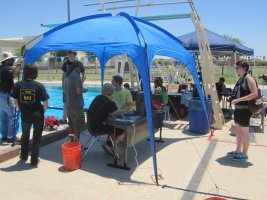
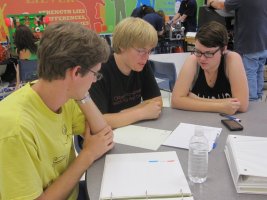
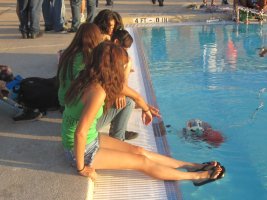
June 9, 2011
Getting things packed up and ready to go to the competition tomorrow bright and early in the morning. I have to stop and get several people on the way, so I might be a bit late. Steven said he'd try to be there at 8.
I also made a quick green charging video.
June 6, 2011
I refinised the float so it would not soak up water. It still had some porous spots, so I sanded the whole thing down, and covered it with a thin layer of autobody filler, sanded again, and painted it. It's better now. I also adjusted the ballast at the front, making it neutral again, and attaching the ballast rods with both velcro and zip ties. Now they can't fall off.
I took Babs to the Candlelighters Family Weekend Retreat at a nearby private campground. David was there with his wife and son (Linus was diagnosed with lukemia 10 years ago, but is doing great now). I got Babs going and drove her around the pool a bit, then let the kids drive...about a dozen wanted to try their hand at it. Fun was had by all.
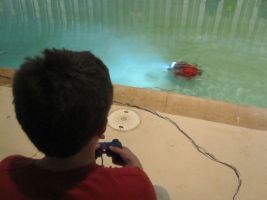
Last night I took Babs up to Tucson, we met up at a relative's pool, with Kevin, Gary, and Steve. Kevin brought notBob. He had done some more programming and got his control system working better. Kevin and Steve spent about an hour practicing driving both ROVs in the same pool at the same time, and Gary and I practiced keeping track of the tethers. Steve noted that it's quite helpful having an overall view of what he's doing.
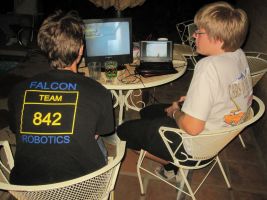

We also took a few pictures of Babs in the water, to show of her sleek new styling.
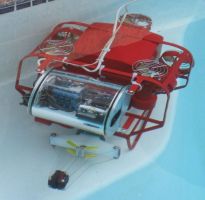
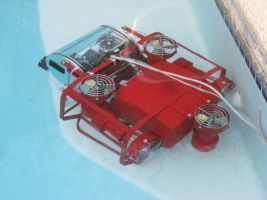
We had problems with the claw on notBob sticking closed. This is a basic design flaw, something to do with the static coefficient of friction being higher than the dynamic. This means that the motor is able to turn the screw easily to clamp the claw on something, but when it tries to unclamp it, the load is too high and it can't. The solution we figured out was to limit closing torque. Kevin reprogrammed the control system to only allow half power when closing the claw. It worked! No more sticking.
June 3, 2011
Today was a bit hectic here in Sierra Vista, what with the backhoe digging up our sewer system. Even so, the technical report and intro video are done.
David is at the cancer camp down here, and we plan to bring Babs there tomorrow night for a demonstration for the kids. Hopefully a few have played video games, and will be able to take her for a spin.
May 31, 2011
We finished the patch on the flotation block, but did not repaint it. We'll see how it does first. Steve made a little bracket to retain the block so it won't move around. I made a new left handed propeller for the forward thruster, so that we can have counter rotating props. This should keep the ROV from twisting when driving forward. I made a quicky prop for the alien life form, using a length of ABS pipe, a bolt and some large heavy nuts, and a piece of building foam.
Steve and I went to Tucson to visit a relative's pool, and meet up with David, Gary, Kevin, and Katie. Kevin brought notBob, and we brought Babs. We stopped by David's house first, hoping that he had done some programming work, but no such luck. We put the ROVs in the pool, and shot some video and took quite a few pictures. We rigged up the alien prop on a piece of fishing line, looped thru a string that was tied to a brick at the bottom of the pool. Pulling the fishing line would sink the prop, releasing would let it rise again. Just like the real ones. Steve practiced catching it as it was raised and lowered, and didn't take long to figure out how to do it.
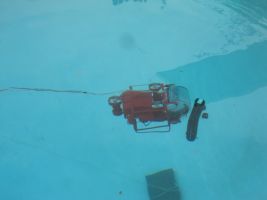
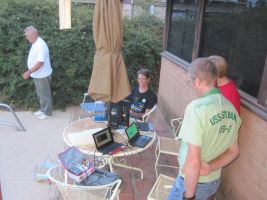
Kevin worked on notBob for a while, trying to get the control system working. Apparently there's some kind of problem with getting the arduino to control two outputs at once, or something. The ROV would drive, or the camera and claw would work, but not all at once. He'll continue to work on figuring it out.
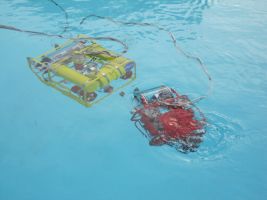
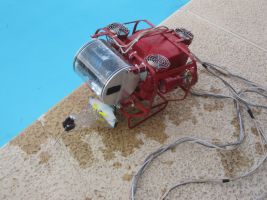
We got a small dial type thermometer to see if it would work for measuring the temperature. It might, but it's kind of hard to read. We might order a similar one with a larger dial, and a smaller range. We'll also get to work on the tech report, and the intro video. They are due Friday!
May 30, 2011
Today we made a lot of progress on the rebuild of Babs! The two forward thrusters have been relocated to sit inside of the frame, taking a total of 6" off of the width of the ROV. The rear vertical thruster was modified to sit further back to allow for more floatation room, and also unbolts to allow for the floaty to be installed. The skids were also re-configured to give Babs a little more clearance on the back when maneuvering in water, and she now stands with her nose pointed up on dry land.
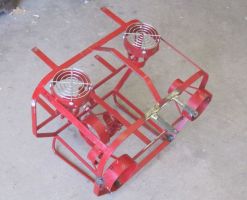
The floaty had finishing touches applied (rounded corners and sanded smooth all over) and got a few coats of red paint. The frame also got a fresh new coat of paint after finishing all of the new modifications. The claw was regreased and given some new inserts to keep the fishing line from getting mangled on the sharp corners of the rusty metal tube that acts as the pivot point. Everything was finally reassembled and we were ready to test!
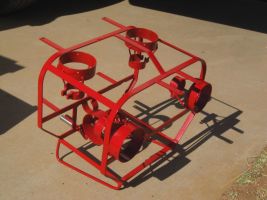
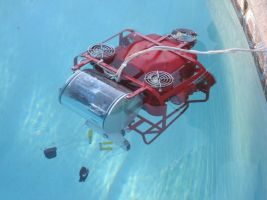
Babs' new configuration worked phenominally in the water. The center of mass is now closer to the center of buoyancy, so fancy maneuvers are easier to carry out. Babs now has the ability to aim and drive straight up or straight down. We still need to make some adjustments to increase performance, but first impressions of the new configuration are great.
We did encounter one snag during the test involving the new float. The first batch of foam was not mixed right and had some spots that didn't cure correctly. A small patch on one of the corners started taking on water, which was first noticed as the robot started sinking. We picked out all of the 'soft' parts of the corner and began to patch it with bondo. Another lesson learned...
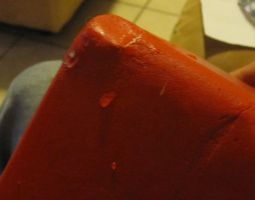
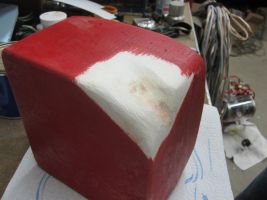
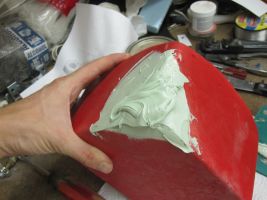
We made a short video that shows Babs in action.
May 29, 2011
Wow, long time since update. Which is ok since we haven't been doing much at all for NURC! We paid the entry fee, and ordered a few more T shirts this week. It's getting to be crunch time, and we have not really done anything to either ROV for quite a while. Today Steve, Gary, Kevin, Janet and I met at a relatives house where there's a pool, and we drove Babs around a bit. She still works fine. We discussed what exactly we want to do for NURC this year. The plan is to go ahead and try to modify Babs to fix the flotation, move the forward thrusters in, reduce the stability (for easier tilting), and work on the feedback depth control program. We will also try to get notBob working well with the new laptop based control system, and use him as the secondary robot. We will work on dividing up the mission among two pilots, Steve will operate Babs, while Kevin will operate notBob.
Steve did some design work in Solidworks to figure out how to modify Babs' flotation. The plan is for a rectangular shaped block of syntactic foam, in the rear center, to replace the two round tanks. The forward thrusters will move inside the frame (as per the original design), and the rear upper thruster will move back a couple inches. To make the foam block work, we need to make it a bit lighter than it should be for it's size, so we wanted to make it hollow. THis is kind of a strange thing to do with syntactic foam, but it seems like the best solution for our design. I worked last week to make the float, and things didn't go too well. I did not mix the material properly, and I didn't make enough, and I didn't make a good form for it. I learned that when they say don't use polyester resin with styrofoam, they mean it! the vapors dissolved the foam I was using to fill the hollow center. Since I didn't make enough material anyways, this ended up working out OK, as I used cardboard to make the center hollow when I attempted to finish it. But that didn't work either, as the additional material I added did not adhere to the first part. So I took the foam box out of the center, and made up a bit more material and glued the two halves together, so now it's a nice hollow syntactic foam box that seems to be strong, light, hollow, and provide just enough flotation.
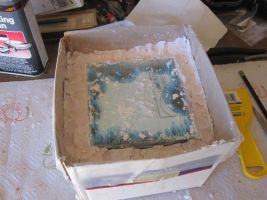
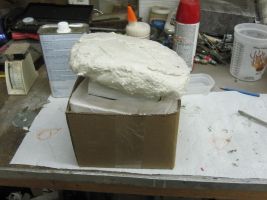
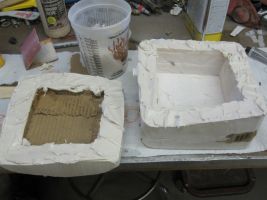
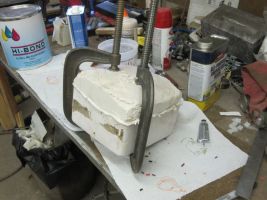
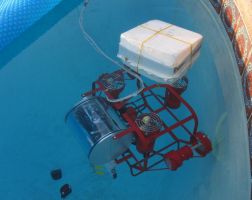
Since the new float is finally fixed so it should work, we took Babs apart and removed the forward and rear upper thrusters. They will fit closer in, and make Babs more compact and hopefully easier to drive in tight quarters.
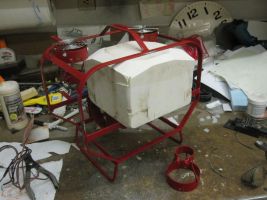
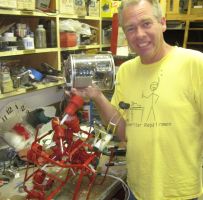
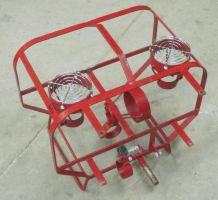
I bought a set of four new 7 Amp hour batteries last fall. We only had one battery box, and needed another to run both ROVs. I finally got around to building the new battery box, using an old plastic tool box. The switches are wired just like the other battery box, but this one features an LED volt meter, so we can monitor the charging voltage. Also we can check the voltage of each battery individually to see how they're all doing.
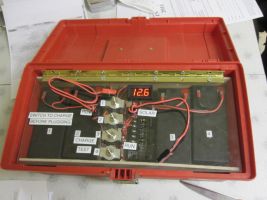
Steven also made a spreadsheet that shows the point value vs. estimated time to accomplish the various tasks. This will help us prioritize ROV activities, so we can be sure the ROVs are capable of doing the important tasks. We already have two ROVs that are quite good at grabbing things like the life forms, for example.
April 24, 2011
We haven't been doing a lot on the underwater robot thing, although we've been talking about it. We are leaning towards modifying Babs (and possibly notBob) to use for the 2011 mission "Trouble on Ceti-Alpha 3!". The basic idea is to keep the control system the same, with the addition of feedback for holding at a constant depth, and to modify the thruster placement and flotation to make Babs more compact and maneuverable.
I did some experimenting with the glass microshperes, making two sample pieces of syntactic foam. The first gave a specific gravity (relative to water) of about 0.5, the second I did not measure, but it had about 30% more spheres in the same amount of resin. The resin is kind of hard to mix thoroughly with the tools we have, and in small quanities of about 8 to 12 fluid ounces. Even so, it looks like it could be made to work for what we need to do, the problem now is redesigning the ROV. Steve is working on it.
I also entered us in the NURC.
March 13, 2011
Kevin played with notBob some more, and got him running. We didn't get a chance to try him in water, though. He configured his arduino board to feed signals to the ROV, and programmed the laptop to take commands from the Logitech gamepad, and convert them to vEx data. Very spiffy.
Steve worked on the basic design of a new ROV, with fewer thrusters, and a more able manipulator, than Babs. The manipulator would have an arm, attached to the side of the SCULL, that would pivot up and down. It would have a rotating claw similar to Babs, at the end of the arm. Right now the proposed plan is to use cables to actuate the wrist and claw, but it might change as the design evolves.
I got a voltmeter for the new battery box, it was supposed to have four digits, but only has three. It does work though, I connected it to the old battery box and watched it as the batteries charged. I think it will work fine.
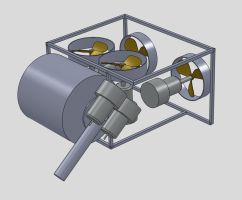
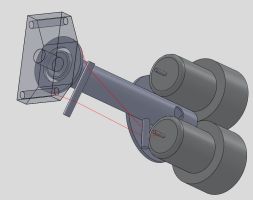
March 9, 2011
I got some parts for the new battery box today. It will look like the old one, but a bit larger, with the batteries on both sides, and the switches and stuff down in the middle, with a cover. Then the controller and ROVotron box and maybe a small tv can be stored in the top. I also ordered a 3.5 digit LED voltmeter, to monitor battery voltage when charging, or to test each battery individually when the charger is disconnected. The ROVotron displays the series battery voltage (nominal 48v) when the system is running. I bought some switches, wire, etc today.
Steve and I discussed the concept of syntactic foam. It turns out that you can make your own, there are a few stores that sell composite supplies (resin, glass cloth, etc) that sell glass microspheres. I looked up some info on the 3M brand products, and found that the type we want is probably the lowest strength, lightest weight spheres. I found a place on ebay that sells them for about $15/gallon, and ordered two gallons. I can buy normal fiberglass resin locally, and we can do some experiments. This will let us mold our own floats, whatever shape we want.
March 7, 2011
I charged the batteries, and Steve and I got Babs in the water. We just wanted to play with the current limiting adjusments on the speed controllers. First we took some data, we found that she could pull with about 2.5 to 3 lbs force down, and forward (separate tests). This drew about 3 amps on the 48v battery pack. THen we took the SCULL apart, turned the limiters to full power, and tried again. Same results. The limiters were set to about 5 amps...per motor...so that should not have surprised us at all. I wonder if larger diameter props would let us use more power?
Steve also worked out some of the math for the vectored drive, he played with a matrix in Excel. He discovered that some drive situations result in undesired drive vectors...hmmmm....maybe the normal way is going to be ok after all.
Kind of discussed ROV ideas with Kevin, he wants to work on using an ESC4 board (2009) in an ROV, controlled by an Arduino and laptop. He's been working on using this hardware for a land based robot, the parts would replace the vEx controller that the ECS4 is designed to work with. I suggested that notBob is sitting here ready to be controlled by something like that, so Steve will drop notBob off with Kevin so he can play.
March 6, 2011
Wow, it's been a while. We've been working on various other things for a while, including an old truck, an old camper, some FRC robots, and a video jacket.
Steve came to visit for a couple days, and got Babs from David on the way. We plan to get her running in the neighbors' pool tomorrow, and do some thrust and speed testing. We'd like to see how fast and strong she is with the current limiters adjsuted as they are now (50%), then repeat the test with the limiters set at full current.
We also talked about a new ROV design, which would be a refinement of Babs. The SCULL would be narrower, the lights fixed to the end plug, the camera would be mounted on the electronics module. The thrusters would be reduced to four, and they would be angled to allow all the required directions of thrust, concentrating on up/down and forward/backward. This is still just a concept, but we thought about some of the complications and also how it would make things easier. Steve will probably make a computer model when he gets home.
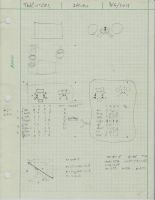
November 14, 2010
The video for Trouble on Ceti Alpha-3 has been posted on youtube.
It looks like the ROV will have to reach down for some tasks, and reach up for others. That got us thinking about adding another degree of freedom to the manipulator.
Redesigning the manipulator to make it move around implies that it might be nice if we could make it smaller too. This has led to us considering using smaller motors, and this might be easier to do if we use something other than bilge pump motors. One possibility is to use brushless motors filled with oil, and a simple seal to keep the oil in and water out. This would in turn require that we explore how to make a motor controller board for brushless motors, and figure out how to program the control system to work with it.
Steve got a job! He moved to Chandler (just a few miles from the event site) and is going to his first day of work at Intel in the morning.
November 1, 2010
The game for the 2011 NURC competition was announced last night. The mission video, props, and cad models of the field elements are not yet posted, so we can't quite figure out what the ROV(s) need(s) to do. However, we've been thinking over the past few months about what changes we would like to make to the design of Babs to make an even better ROV.
More speed! Gotta have more speed. Adding two more forward thrusters would help.
Automatic depth control. We could play with adding a feedback loop to the pressure sensor (depth gage), tied into the vertical thrusters, to allow the pilot to push a button on the controller and have the ROV hover at a constant depth.
Simpler light and camera mount. After thinking about it more, we realized that we could have mounted the LEDs in a fixed location, pointing mostly forward and down. This would allow the camera mount to be much simpler, and take less servo power to move it. There could be nothing mounted to one of the end plates of the SCULL.